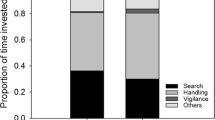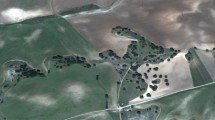Abstract
Spatial and temporal variation in resource distribution affect the movement and foraging behavior of many animals. In the case of animal-dispersed trees, numerous studies have addressed masting—the synchronized variation in seed production between years—but the fitness consequences of spatial variation in seed production within a year are unclear. We investigated the effects of variable acorn production in a population of valley oaks (Quercus lobata) on the composition and behavior of the avian-disperser community. We found that western scrub-jays (Aphelocoma californica), high-quality dispersers that store seeds in the ground, were attracted to, and exhibited increased per capita dispersal rates from, trees with large acorn crops. In contrast, acorn woodpeckers (Melanerpes formicivorus), low-quality dispersers that store acorns in trees where they are unlikely to germinate, increased per capita hoarding rates but did not attend trees with large seed crops in higher numbers, suggesting that the two species responded to resources on different spatial scales. Antagonistic interactions within and between species increased with the number of birds attending a tree, resulting in a potential cost for foraging birds, but did not reduce dispersal rates. Using a simulation model, we estimated that trees with large initial crops experienced a greater proportion (77 %) of high-quality seed dispersal events than trees with small crops (62 %). Our findings provide support for a mechanistic link between seed production and foraging behavior of seed dispersers as predicted by the predator dispersal hypothesis for the functional consequences of variable seed production in hoarder-dispersed trees.


Similar content being viewed by others
References
Andersson M, Krebs J (1978) On the evolution of hoarding behaviour. Anim Behav 26:707–711
Bates D, Maechler M, Bolker B (2012) lme4: linear mixed-effects models using S4 classes. R package version 0.999999-0
Bolker BM, Brooks ME, Clark CJ, Geange SW, Poulsen JR, Stevens MHH, White JSS (2009) Generalized linear mixed models: a practical guide for ecology and evolution. Trends Ecol Evol 24:127–135
Borchert MI, Davis FW, Michaelsen J, Oyler LD (1989) Interactions of factors affecting seedling recruitment of blue oak (Quercus douglasii) in California. Ecology 70:389–404
Brown JS (2000) Foraging ecology of in animals in response to heterogeneous environments. In: Hutchings J, Stewart A (eds) The ecological consequences of environmental heterogeneity. Blackwell Scientific, Oxford, pp 181–215
Carmen WJ (2004) Behavioral ecology of the California scrub jay (Aphelocoma californica): a non-cooperative breeder with close cooperative relatives. Stud Avian Biol. 28:1–100
Charnov EL (1976) Optimal foraging, the marginal value theorem. Theor Popul Biol 9:129–136
Christensen KM, Whitham TG, Balda RP (1991) Discrimination among pinyon pine trees by Clark's Nutcrackers: effects of cone crop size and cone characters. Oecologia 86:402–407
Côrtes MC, Uriarte M (2013) Integrating frugivory and animal movement: a review of the evidence and implications for scaling seed dispersal. Biol Rev 88:255–272
DeGange AR, Fitzpatrick JW, Layne JN, Woolfenden GE (1989) Acorn harvesting by Florida scrub-jays. Ecology 70:348–356
Dixon MD, Johnson WC, Adkisson CS (1997) Effects of weevil larvae on acorn use by blue jays. Oecologia 111:201–208
Fox J, Weisberg S (2011) An R companion to applied regression. Sage, Thousand Oaks
Gerber LR, Reichman OJ, Roughgarden J (2004) Food hoarding: future value in optimal foraging decisions. Ecol Mod 175:77–85
Gómez JM (2003) Spatial patterns in long-distance dispersal of Quercus ilex acorns by jays in a heterogeneous landscape. Ecography 26:573–584
Jablonski P, Lee SI, Fuszara E, Fuszara M, Jeong C, Lee W (2015) Proximate mechanisms of detecting nut properties in a wild population of Mexican Jays (Aphelocoma ultramarina). J Ornithol 156:163–172
Kelly D, Sork VL (2002) Mast seeding in perennial plants: why, how, where? Annu Rev Ecol Evol Syst 33:427–447
Kelly D, Geldenhuis A, James A, Penelope Holland E, Plank MJ, Brockie RE, Cowan PE, Harper GA, Lee WG, Maitland MJ, Mark AF (2013) Of mast and mean: differential-temperature cue makes mast seeding insensitive to climate change. Ecol Lett 16:90–98
Koenig WD, Benedict LS (2002) Size, insect parasitism, and energetic value of acorns stored by acorn woodpeckers. Condor 104:539–547
Koenig WD, Haydock J (1999) Oaks, acorns, and the geographical ecology of acorn woodpeckers. J Biogeogr 26:159–165
Koenig WD, Knops JMH (2000) Patterns of annual seed production by northern hemisphere trees: a global perspective. Am Nat 155:59–69
Koenig WD, Knops JMH (2013) Large-scale spatial synchrony and cross-synchrony in acorn production by two California oaks. Ecology 94:83–93
Koenig WD, Mumme RL (1987) Population ecology of the cooperatively breeding acorn woodpecker. Princeton University Press, Princeton
Koenig WD, Mumme RL, Carmen WJ, Stanback MT (1994) Acorn production by oaks in central coastal California: variation within and among years. Ecology 75:99–109
Koenig WD, Knops JMH, Carmen WJ (2002) Arboreal seed removal and insect damage in three California oaks. In: Standiford RB, McCreary D, Purcell KL (tech coords) Proceedings of 5th Symposium on Oak Woodlands: Oaks in California’s Changing Landscape. General technical report PSW–GTR–184. Pacific SW Forest and Range Experimental Station
Koenig WD, Kelly D, Sork VL, Duncan RP, Elkinton JS, Peltonen MS, Westfall RD (2003) Dissecting components of population-level variation in seed production and the evolution of masting behavior. Oikos 102:581–591
Koenig WD, McEntee JP, Walters EL (2008) Acorn harvesting by acorn woodpeckers: annual variation and comparison with genetic estimates. Evol Ecol Res 10:811–822
Koenig WD, Krakauer AH, Monahan WB, Haydock J, Knops JMH, Carmen WJ (2009) Mast-producing trees and the geographical ecology of western scrub-jays. Ecography 32:561–570
Koenig WD, Walters EL, Pearse IS, Carmen WJ, Knops JMH (2014) Serotiny in California oaks. Madroño 61:151–158
Lichti NI, Steele MA, Zhang H, Swihart R (2014) Mast species composition alters seed fate in North American rodent-dispersed hardwoods. Ecology 95:1746–1758
MacRoberts MH (1970) Notes on the food habits and food defense of the acorn woodpecker. Condor 72:196–204
Morgan RA, Brown JS, Thorson JM (1997) The effect of spatial scale on the functional response of fox squirrels. Ecology 78:1087–1097
Pesendorfer MB (2014) Scatter-hoarding of acorns by island scrub-jays. Ph.D. thesis, University of Nebraska-Lincoln
Pesendorfer MB, Langin KM, Cohen B, Principe Z, Sillett TS, Morrison SA (2014) Stand density and acorn production of the island scrub-oak (Quercus pacifica). Monogr West North Am Nat 7:246–259
Pesendorfer MB, Sillett TS, Koenig WD, Morrison SA (2016) Scatter-hoarding corvids as seed dispersers for oaks and pines: a review on a widely distributed mutualism and its utility to habitat restoration. Condor 118:215–237
Pons J, Pausas JG (2007) Acorn dispersal estimated by radio-tracking. Oecologia 153:903–911
Poulsen JR, Clark CJ, Connor EF, Smith TB (2002) Differential resource use by primates and hornbills: implications for seed dispersal. Ecology 83:228–240
R Core Team (2013) R: a language and environment for statistical computing. R Foundation for Statistical Computing, Vienna. ISBN 3-900051-07-0. http://www.R-project.org/
Schupp EW, Jordano P, Gómez JM (2010) Seed dispersal effectiveness revisited: a conceptual review. New Phytol 188:333–353
Scofield DG, Sork VL, Smouse PE (2010) Influence of acorn woodpecker social behaviour on transport of coast live oak (Quercus agrifolia) acorns in a southern California oak savanna. J Ecol 98:561–572
Vander Wall SB (1990) Food hoarding in animals. University of Chicago Press, Chicago
Vander Wall SB (2002) Masting in animal-dispersed pines facilitates seed dispersal. Ecology 83:3508–3516
Vander Wall SB (2010) How plants manipulate the scatter-hoarding behavior of seed-dispersing animals. Philos Trans R Soc B 365:989–997
Yi X, Wang Z (2015) Context-dependent seed dispersal determines acorn survival of sympatric oak species. Plant Ecol 216:123–132
Zuur AF (2009) Mixed effects models and extensions in ecology with R. Springer, Berlin
Zwolak R, Bogdziewicz M, Wróbel A, Crone EE (2015) Advantages of masting in European beech: timing of granivore satiation and benefits of seed caching support the predator dispersal hypothesis. Oecologia. doi:10.1007/s00442-015-3511-3
Acknowledgments
This research was funded by NSF grant DEB-1256394. We thank two anonymous reviewers for comments, Spencer Schubert and Kachina Rowland for assistance with data collection, and Vince Voegeli, the Hastings Reservation, and the Museum of Vertebrate Zoology, UC Berkeley, for logistical support.
Author contribution statement
M. B. P. and W. D. K. conceived and designed the research. M. B. P. collected and analyzed the data. M. B. P. and W. D. K. wrote the manuscript.
Author information
Authors and Affiliations
Corresponding author
Additional information
Communicated by Christopher Whelan.
Electronic supplementary material
Below is the link to the electronic supplementary material.
Rights and permissions
About this article
Cite this article
Pesendorfer, M.B., Koenig, W.D. The effect of within-year variation in acorn crop size on seed harvesting by avian hoarders. Oecologia 181, 97–106 (2016). https://doi.org/10.1007/s00442-016-3557-x
Received:
Accepted:
Published:
Issue Date:
DOI: https://doi.org/10.1007/s00442-016-3557-x




